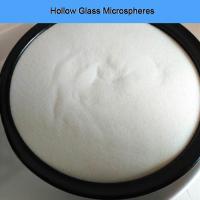1. Production Description
Hollow glass Microsphere is ultra-light inorganic and non-metallic
material. Its true density is 0.12 -0.70g/c m3g/cm³, particle size
is 2-120μm,and its compressive strength ranges 4-125MPa, it has the characteristics of light weight, large volume, low
thermal conductivity, high compressive strength, and good fluidity.
It is a product filler and lightening agent in paint coatings,
rubber, modified plastics, glass fiber reinforced plastic,
artificial stone, putty and other industries; due to its high
strength, high compressive and low density, it is widely used in
oilfield cementing mud and drilling liquid.
2. Physical Index of Hollow Glass Bubbles
True Density | 0.12-0.70g/cm3 |
Bulk Density | 0.10-0.40g/cm3 |
Crush Strength | 4-125Mpa/500-18000Psi |
Survival | Min 90% |
Flotation | Min 92% |
Moisture | Max 0.5% |
Particle Size | D50:20-70um |
Max. Particle Size: | 200um |
Melting Point | 1600°C |
3. Main Models and Specification of Hollow Glass Microsphere
Types | True Density
(g/cm3) | Bulk Density
(g/cm3) | Compressive
Strength (Mpa/PSI) | Particle size |
D50 (μm) | D90 (μm) |
H20 | 0.20-0.22 | 0.10-0.12 | 4/500 | 65 | 110 |
H22 | 0.21-0.24 | 0.11-0.13 | 5/750 | 65 | 100 |
H25 | 0.24-0.27 | 0.13-0.15 | 5/750 | 65 | 100 |
H28 | 0.27-0.30 | 0.14-0.17 | 10/1500 | 55 | 85 |
H30 | 0.29-0.32 | 0.15-0.18 | 10/1500 | 55 | 85 |
H32 | 0.31-0.33 | 0.17-0.19 | 14/2000 | 45 | 80 |
H35 | 0.33-0.37 | 0.18-0.21 | 21/3000 | 40 | 70 |
H38 | 0.37-0.39 | 0.19-0.22 | 38/5500 | 40 | 65 |
H40 | 0.39-0.42 | 0.19-0.23 | 28/4000 | 40 | 70 |
H42 | 0.41-0.44 | 0.21-0.24 | 55/8000 | 40 | 60 |
H46 | 0.44-0.48 | 0.23-0.26 | 41/6000 | 40 | 70 |
H50 | 0.48-0.52 | 0.25-0.27 | 55/8000 | 40 | 60 |
H55 | 0.53-0.57 | 0.27-0.29 | 69/10000 | 40 | 60 |
H60 | 0.58-0.62 | 0.29-0.34 | 83/12000 | 40 | 65 |
4. Properties of Hollow Glass Microsphere Bubble
1)Color and shape: pure white flowable powder.
2)Light weight and large volume
The density of hollow glass microspheres is about one-tenth of the
density of traditional filler particles. When used as filler, it
can greatly reduce the basis weight of the product, replace and
save more production resin, and reduce product cost.
3)High dispersion and good fluidity
They have better fluidity in liquid resin than fillers in the form
of flakes, needles or irregular shapes, so they have excellent mold
filling performance. What's mpre, the small microbeads are
isotropic, so they will not cause the inconsistency of shrinkage of
different parts due to orientation, and ensure the product's
dimensional stability and without warpage.
4)Insulation, sound insulation, insulation, low water absorption
The inside of the hollow glass beads is a thin gas, so it has the
characteristics of sound insulation and heat insulation, and it is
an excellent filler for various heat insulation and sound
insulation products. The thermal insulation properties of hollow
glass microspheres can also be used to protect the product from
thermal shock caused by alternating changes between rapid heating
and rapid cooling conditions. The high electrical resistivity and
the extremely low water absorption make it widely used in the
production of cable insulation materials.
5)Low oil absorption
The particles of the sphere determine its minimum specific surface
area and low oil absorption rate. The amount of resin can be
greatly reduced in use. Even under the premise of high addition,
the viscosity will not increase much, it greatly improves the
production operating conditions. Increase production efficiency by
10%-20%.
5. Application of Hollow Glass Microsphere
1)Building materials in the field which using its thermal
insulation effect, mainly for reflective insulation coating, putty,
adhesives and so on.;
2)Low-density FRP (fiberglass-reinforced plastic), SMC, BMC
composites.
3)Nylon, PA, PA6, PA66 for reducing weight.
4)Low-density adhesives & sealants.
5)Emulsion Explosives
6)Oil and gas exploration in the field of drilling fluid used as a
low-density and low-density cement slurry.










